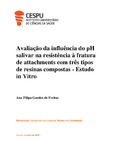| dc.contributor.advisor | Santos, Primavera Conceiçao Martins de Sousa | |
| dc.contributor.author | Freitas, Ana Filipa Guedes de | |
| dc.date.accessioned | 2023-11-15T09:16:24Z | |
| dc.date.available | 2023-11-15T09:16:24Z | |
| dc.date.issued | 2023 | |
| dc.identifier.uri | http://hdl.handle.net/20.500.11816/4264 | |
| dc.description.abstract | Introdução: Com o decorrer dos anos, o uso de sistemas de alinhadores transparentes como tratamento ortodôntico, tornou-se cada vez mais frequente devido às suas vantagens quer estéticas, quer funcionais. Para melhorar a previsibilidade, a eficácia do movimento dentário e obter um maior controlo dos movimentos complexos, foram desenvolvidos attachments auxiliares em resina composta. Objetivo: Avaliar a influência do pH salivar na resistência à fratura de attachments comparando três tipos de resinas compostas: G1 o compósito Synergy R D6 Dentin A4/C4 (Coltene, USA); G2 – o compósito Bulk Fill A3 (3M™ Filtek™ One Bulk Fill Restorative, USA) e o G3 - o compósito Tetric EvoFlowR A2 (Ivoclar Vivadent Inc, USA). Material e métodos: Foram utilizados 90 dentes incisivos inferiores permanentes bovinos. Os attachments foram aderidos à superfície dentária usando um template e o Protocolo de adesão: ácido ortofosfórico 37%, (DF Dentaflux, ES) e adesivo Scotchbond Universal (3M™ Scotchbond™ Universal Adhesive, GmbH, Alemanha). Aleatoriamente os 90 dentes foram divididos equitativamente pelos três grupos G1,G2,G3. Cada grupo foi dividido em 3 subgrupos; O G1a, G2a, G3a com 10 dentes cada em ambiente seco, grupo controle. Os G1b, G2b, G3b com 10 dentes cada foram imersos em saliva artificial a pH 4 em estufa a 37º. O G1c, G2c, G3c com 10 dentes cada foram imersos em saliva artificial a pH 7 em estufa a 37º. Todos os dentes foram sujeitos a um teste simples de carga à velocidade constante de 1mm/min na máquina universal Instron®. Resultados: O resultado mais baixo relativamente à resistência à fratura de todo o estudo foi detetado no G3c (M=137.11, DP=32.21). Por outro lado, o G1c apresentou o resultado mais elevado de resistência até à fratura de todo o estudo (M=234.11, DP=44.73). Os G1 e G2 apresentaram um desempenho superior no que se refere à resistência à fratura comparativamente ao G3. Conclusão: Os resultados sugerem que os compósitos SynergyR D6 Dentin A4/C4 (Coltene, USA) e Bulk Fill A3 (3M™ Filtek™ One Bulk Fill Restorative, USA) apresentaram um desempenho superior no que se refere à resistência à fratura comparativamente ao compósito Tetric EvoFlowR A2 (Ivoclar Vivadent Inc, USA). O pH salivar de 4 e de 7 não influenciou na resistência à fratura nos três tipos de compósitos utilizados.
Palavras-chave: alinhadores invisíveis; compósitos; pH salivar; attchment.vi | pt_PT |
| dc.description.abstract | Introduction: Over the past few years, clear aligner system as orthodontic treatment was more common due to their advantages: funcional and aesthetic benefits. In order to improve predictability, the effectiveness of tooth movement and to obtain greater control of complex movements, auxiliary composite resin attachments have been developed. Objective: Evaluate the influence of pH on the fracture resistance of attachments by comparing three types of composite resins: the composite SynergyR D6 Dentin A4/C4 (Coltene, USA) G1; Bulk Fill A3 (3M™ Filtek™ One Bulk Fill Restorative, USA) G2 and Tetric EvoFlowR A2 (Ivoclar Vivadent Inc, USA)G3. Material and methods: 90 bovine permanent lower incisor teeth were used. The attachments were adhered to the tooth surface using a template and the Bonding Protocol: 37% orthophosphoric acid, (DF Dentaflux, ES) and Scotchbond Universal adhesive (3M™ Scotchbond™ Universal Adhesive, GmbH, Germany). Material and methods: 90 bovine permanent lower incisors were used. The attachments were adhered to the tooth surface using a template and the Adhesion Protocol: 37% orthophosphoric acid, (DF Dentaflux, ES) and Scotchbond Universal adhesive (3M™ Scotchbond™ Universal Adhesive, GmbH, Germany). Then, they were randomly divided into the groups (G1, G2 and G3). Each group was separated in 3 subgroups; G1a, G2a, G3a with 10 teeth each in a dry control environment; G1b, G2b and G3b with 10 teeth which were immersed in artificial saliva at pH 4 in an oven at 37º; G1c, G2c and G3c with 10 teeth which were immersed in artificial saliva at pH 7 in an incubator at 37ºC. All teeth were subjected to a simple load test at a constant speed of 1 mm/min in a universal Instron® machine. Results: The fracture toughness of G3c was the lowest in the entire study (M=137.11, SD=32.21). On the other side, composite G1c achieved the highest resistance to fracture in the entire study (M=234.11, SD=44.73). Groups G1 and G2 showed superior performance in terms of fracture toughness compared to G3. Conclusion The results suggest that SynergyR D6 Dentin A4/C4 (Coltene, USA) and Bulk Fill A3 (3M™ Filtek™ One Bulk Fill Restorative, USA) composites showed superior performance in terms of fracture toughness when compared to Tetric EvoFlowR A2 composite (Ivoclar Vivadent The salivary pH of 4 and 7 did not influence the resistance to fracture in the three types of composites used. | pt_PT |
| dc.language.iso | por | pt_PT |
| dc.rights | info:eu-repo/semantics/openAccess | pt_PT |
| dc.subject | Clear aligners | pt_PT |
| dc.subject | PH saliva | pt_PT |
| dc.subject | Attachment orthodontics | pt_PT |
| dc.subject | Composite | pt_PT |
| dc.title | Avaliação da influência do pH salivar na resistência à fratura de attachments com três tipos de resinas compostas - Estudo in Vitro | pt_PT |
| dc.type | info:eu-repo/semantics/masterThesis | pt_PT |
| dc.identifier.tid | 203377346 | pt_PT |
| thesis.degree.name | Mestrado em Ortodontia | pt_PT |

